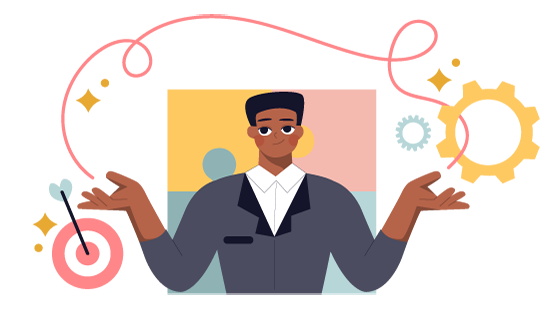The ’80s meant acid-washed jeans, big hair, and a lot of neon. But way back in 1987, John Keller came up with a theory known as the ARCS model.
Keller is currently a professor of instructional systems and educational psychology at the University of Florida, and his ARCS model is essentially a way to marry instructional design with learner motivation for the best possible result.
Of course, Keller’s instructional development model was created for traditional teachers and instructors—those teaching face-to-face with their students. But although it’s over 30 years later, the ARCS model still applies.
What is the ARCS model of instructional design?
ARCS is a framework for designing motivating learning environments. ARCS stands for four components of learner motivation—attention, relevance, confidence, and satisfaction.
These four components are just as important today as they were in the ’80s. By checking your courses and instruction against the modern ARCS model, you may find yourself tweaking your material and methods to make sure your eLearners actually, you know, want to learn.
Keller rooted the ARCS model based on his research on human motivation and learning. Keller wanted to create a model that could help instructional designers and educators design courses that would capture and sustain learners’ attention and increase their desire to engage with the material.
He identified four main factors in the learning process that influence this motivation: attention, relevance, confidence, and satisfaction.
The ARCS model provides guidelines and strategies for each factor as well as methods to assess the motivational impact of a learning environment. Although built in the ’80s, the model is widely used today in various fields of education and training such as eLearning, corporate training, health education, and military training.
Attention
Of course, you want your learners to sit up and take notice—but how? The ARCS model approach uses attention first because a course needs to engage learners immediately. Whether it’s a digital invitation to a company-wide course or utilizing graphics to present an old idea in a new way, you only get one chance to make a first impression. Do it right and learners are excited about the prospect of engaging with the material. Fail and you could have disgruntled learners rolling their eyes at the idea of another boring, mandatory course. By using the design to hype the class or course, you have a better chance of getting willing bodies in the e-classroom.
Grabbing learner attention today
In today’s fast-paced, highly competitive world where instant messaging, super-multitasking, and workers engaged in multiple gigs is the norm, learner attention is a scarce commodity. However, capturing learners’ attention is the first step toward effective instruction. To create an attention-grabbing learning experience, consider incorporating the following strategies:
- Incorporate multimedia elements in your lessons, such as videos, images, or interactive simulations to stimulate curiosity.
- Start with a thought-provoking question, a surprising fact, or a real-life scenario to pique learners’ interest.
- Include storytelling techniques to create an emotional connection and engage learners on a personal level.
Relevance
Let’s face it—in today’s hectic corporate setting, the interest employees have in courses and classes boils down to one question: “What’s in it for me?” In the eLearning arena, your best bet to motivate a learner is to highlight the benefits for and how it relates to the individual, rather than the organization.
Whether it’s the knowledge and certification to move forward in a career, better communication skills, or learning new standards to become compliant with the industry, learners need to understand the why behind the course or you risk them losing interest before they even start. If the instructional design models used are such that learners don’t connect with the material, your course could fall flat.
When creating relevant eLearning material, you have several assets at your disposal to help a learner connect with and get more from the experience. While the content and writing help your students get the facts, it’s the graphic design—pictures, graphs, and multimedia—that help your learners better connect with the material on a more personal level. You can increase learner motivation with a focus on relevance.
Making learning relevant today
Back in the ’80s, when Keller conceptualized his ARCS instructional development model, the corporate world was one built around specialization. There was broad encouragement for employees to do one thing—and to do it well! All that’s changed since. Today’s learning must, therefore, make content relevant to employees on multiple fronts.
So, once you have a learner’s attention, the next step is to establish the relevance of the content to their needs and goals. Here are some practices to enhance relevance:
- At the outset, articulate the learning objectives clearly and spell out how they relate to learners’ real-life situations or challenges.
- Include examples and case studies that showcase the practical applications of the concepts they’ll learn.
- Encourage learner autonomy by allowing them to choose projects or assignments that align with their work roles, interests, or professional aspirations.
Confidence
Here’s where a flipped model of instruction can really work in your favor. When a learner feels confident about the material and the instruction, they’re more motivated to try again. When you simply read from a paper or deliver a lecture, you miss out on the opportunity for learners to test their newfound skills and knowledge.
As part of the learning process, by asking students to view course material online before class, you can then use class time to roleplay, test, and discuss the new concepts. Case studies, group discussions, and even gameplay can help your students feel better about the application of new ideas. This can help your learners feel more comfortable with the material and ready to put it to work in the real world—after all, that’s the point of the course.
Confidence-building in today’s learning environment
Building learner confidence in their ability to succeed is crucial for maintaining their motivation. Thanks to advances in learning technologies today (compared to the ’80s), L&D professionals have many more confidence-building tools and strategies in their toolboxes. Consider the following strategies to foster confidence:
- Use a building-block approach to your design and delivery approach. Break down complex concepts into manageable chunks and provide clear explanations, thereby scaffolding learner understanding. Getting learners to crawl before they walk (and walk before they run) can be a huge confidence-booster!
- Offer regular feedback and praise learner progress to boost their self-confidence.
- Incorporate opportunities for practice and skill-building, gradually increasing the complexity to foster competence.
- Leverage learning analytics to customize exercises and learning tasks for relevance. Make your content as real-life-like as (and appropriate to) the environment a learner will face when they return to work and apply their learning. Do that by using 3D simulations, virtual reality (VR), augmented reality (AR), 360 videos, and mixed reality (MR) when designing practice exercises and tests.
Satisfaction
To be successful, instructional design models must value a learner’s investment in learning. Your students invest time in eLearning, so the least you can do is make sure they leave feeling satisfied and as though their time was well spent.
This often means putting new concepts to work as soon as your students leave the classroom. If you just completed course material based on improved sales tactics, for example, you could immediately send out a case study to which students can apply their new knowledge.
Further activities, follow-up, and even group projects can further help your students see the difference the course material makes in the real world, amping up satisfaction and interest in future courses.
Eliciting learner satisfaction today
Given how “time-taxed” today’s learners are, it’s important to leave them satisfied with every learning interaction—or else they may not sustain their learning journey for too long. To sustain motivation and ensure a positive learning experience, it is essential to create a sense of fulfillment. Here are some best practices:
- Design assessments that provide learners with a sense of accomplishment at each stage of the learning journey.
- Include tasks, projects, and assignments modeled on real-world scenarios that allow them to demonstrate their newfound knowledge or skills.
- Provide constructive feedback that highlights strengths and offers suggestions for improvement.
- Celebrate milestones and achievements to reinforce learner motivation and encourage further engagement.
Implementing the ARCS model in instructional design
As you might gather by now, the ARCS model approach of instructional design provides L&D with a structured framework to create engaging and motivating learning experiences. It does so by focusing on core motivational traits—attention, relevance, confidence, and satisfaction. Instructional designers can leverage these traits to design instruction that captures learner interest, connects with their goals, builds their confidence, and fuels a continued thirst for learning.
So, let’s put everything we’ve discussed together. Here are some key considerations when implementing ARCS to design engaging, motivational learning for today’s learners:
- Learner-centered design: Tailor the learning experience to the needs, preferences, and prior knowledge of the learners.
- Leverage “What’s-in-it-for-me?” (WIIFM): Explain the benefits and outcomes of learning the content and how it can help solve problems or improve performance.
- Clear communication: Use clear and concise language and avoid jargon to ensure learners can easily understand the content.
- Challenge existing assumptions: Ask questions and present problems that stimulate curiosity and challenge existing learner assumptions about the subject.
- Interactivity and collaboration: Incorporate interactive elements such as discussions, group activities, and collaborative projects as part of your instructional development strategy to promote engagement and peer learning. Leverage learning tech to its fullest. Don’t be afraid to use simulation, gamification, VR/AR, and MR elements in your design.
- Personalization: Offer opportunities for learners to personalize their learning path, allowing them to explore topics of interest and apply concepts to their specific contexts.
- Ongoing evaluation: Continuously assess the learning process and the effectiveness of the instructional design, gather feedback from learners, and make necessary adjustments to optimize the learning experience. Use modern learning data analytics to inform your critique and feedback.
By following these steps and strategies, you can implement Professor Keller’s ARCS model approach in your instructional design projects. This will help you create learning experiences that are not only informative, but also engaging, meaningful, and motivating for your learners.
The ARCS Model’s Enduring Impact
So, while Keller created his model way back when acid wash was actually cool, a few modern twists can help you apply his theory to instructional design. By creating course material based on the factors that keep your learners motivated, you help increase interest and retention for more effective training.






